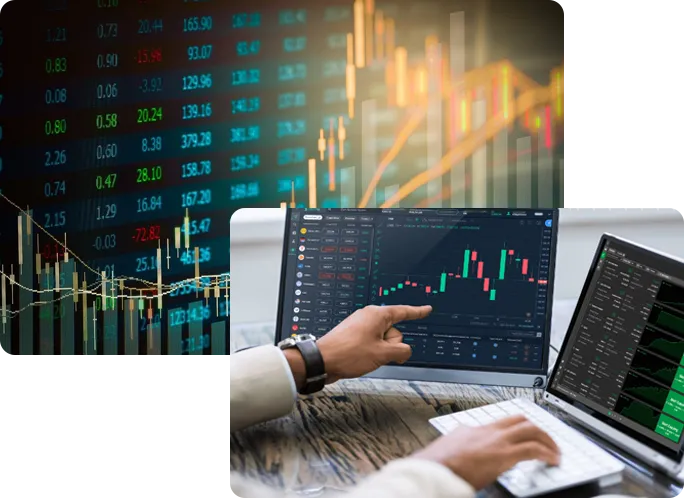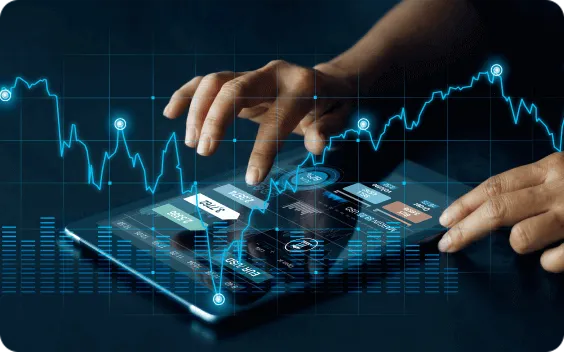IMMEDIATE XTRADE AI


Immediate XTrade AI is an algo-based protocol which implements Python programs via a Kinetic Monte Carlo (KMC) logic or framework. In essence, the KMC approach derives it’s logic based on a correlation between time and processes. This framework has been adapted and adjusted to address weaknesses that clearly influence the results or profit margins associated with the vast majority of crypto trading apps in the market.
In layman’s terms, Immediate XTrade AI uses AI protocols in order to exploit prices gaps in certain order types. These orders types use a sorting methodology which is symmetrical or linear. In such a scenario, predictive analysis powered by a robust AI engine is exactly the kind of system architecture which is needed to create an effective trading environment.


Immediate XTrade AI isn’t just an app or service. First and foremost it is a vision of wealth coupled with simplicity and a willingness to take a small risk. New members will be a part of a new and exclusive community of traders. It's time to take charge of your financial future and start generating life-changing profits consistently.

Registration is a simple and straight-forward process. Simply click on the register now or sign up button. Enter your full name, phone number, email, and select a password. Make sure to enter your correct details since this is critical for your onboarding process.
Once registration is complete phone verification is usually required before you are allowed to fund your account. Please note that phone verification will also make it easier for you to withdraw your money once you reach the desired balance.
Once you are phone verified you can proceed to fund your trading account. This is usually done with the assistance of an account manager via phone. However, a cashier can also be made available for funding once your identity has been confirmed.


Automated trading, also known as algorithmic trading or mechanical trading, refers to the use of computer programs or algorithms to automatically execute trading strategies in financial markets. Instead of relying on human traders to manually place trades, automated trading systems can analyze market data, identify trading opportunities, and execute trades without human intervention.
Artificial intelligence (AI) plays a crucial role in online trading, transforming the way financial markets operate and how traders make investment decisions. This is particularly true when it comes to risk management, data analysis, and market surveillance (but not only).
Order sorting in online trading refers to the process of arranging and prioritizing buy and sell orders based on certain criteria. The goal of order sorting is to match buy orders with sell orders in a fair and efficient manner to facilitate the execution of trades. Artificial Intelligence scripts like the ones used with Immediate Xtrade AI employ such sorting methodologies and in that way increase efficiency levels.
Quants or Quantitative Analysts are exceptionally smart people who truly understand applied Mathematics and Statistics. Quantitative Analysis is a method used in various fields, including finance, economics, and science, to understand and interpret data through mathematical and statistical techniques. In the context of finance and investment, quantitative analysis involves the use of mathematical models, statistical tools, and computational algorithms to analyze financial data and make informed decisions about investment opportunities.
Immediate Xtrade AI uses a proprietary coding tool nicknamed a “Quant Patch” which is used for statistical modeling. This patch can be viewed as an added layer of technology designed for predictive analysis and risk management. The Quant Patch can be deployed in two different trading instruments or environments as can be seen be seen in the examples below.
Cryptocurrency trading involves the buying, selling, and exchanging of digital currencies on various online platforms called cryptocurrency exchanges. However, it's also possible to purchase crypto CFD's or contracts for differences. This can only be done when using brokers or brokerages. Immediate Xtrade AI uses vetted CFD brokers specializing in cryptocurrency trading. These brokers are allocated upon registration for new customers.
Forex, short for foreign exchange, refers to the global decentralized market where currencies are traded. It is the largest and most liquid financial market in the world, with an average daily trading volume exceeding $6 trillion as of 2021. Forex trading involves the buying, selling, and exchanging of currencies with the aim of profiting from fluctuations in exchange rates.
In trading, order types refer to the specific instructions given to a broker or a trading platform to execute a trade. These instructions dictate how and when a trade should be executed. Different order types are used to achieve various trading objectives and to manage risk. Here are some common order types:
These are just some of the most common order types used in trading. Each order type serves different purposes and provides traders with flexibility in executing their trading strategies while managing risk and ensuring efficient trade execution.
Managing risk in cryptocurrency trading is crucial due to the high volatility and uncertainty inherent in cryptocurrency markets. Here are some strategies for effectively managing risk when trading cryptocurrencies:
By implementing these risk management strategies, cryptocurrency traders can better protect their capital, minimize losses, and improve their overall trading performance in the volatile cryptocurrency markets.

Emotional trading refers to making trading decisions based on emotions rather than rational analysis and strategic planning.
It occurs when traders allow their emotions, such as fear, greed, excitement, or frustration, to influence their decision-making process in the financial markets.
Emotional trading can lead to impulsive and irrational decisions, resulting in poor trading outcomes and increased risk of losses. Here are some common manifestations of emotional trading: Fear, Greed, Excitement, and Frustration.
Emotional trading can be detrimental to trading performance and profitability. It can lead to inconsistent decision-making, lack of discipline, and increased susceptibility to market noise and manipulation.
To overcome emotional trading, traders should focus on developing a disciplined trading plan based on sound analysis, risk management principles, and predefined trading rules. They should also cultivate emotional awareness, practice mindfulness techniques, and strive to maintain a rational and objective mindset while trading.
Additionally, seeking support from mentors, trading communities, or professional counselors can help traders manage emotions and develop healthy trading habits.
Choosing the best online trading strategy depends on various factors, including your financial goals, risk tolerance, time commitment, market conditions, and trading experience.
Choosing the best online trading strategy requires careful consideration of your goals, risk tolerance, market conditions, and trading style.
Technical indicators are mathematical calculations based on historical price, volume, or other market data used by traders and analysts to identify trends, predict future price movements, and make informed trading decisions.
These indicators are applied to charts of financial instruments, such as stocks, forex pairs, cryptocurrencies, and commodities, to provide insights into market behavior.
Setting limits in online trading refers to establishing predefined price levels at which you intend to enter or exit trades automatically. These limits help traders manage risk, lock in profits, and maintain discipline in their trading activities.
It’s plain to see that it can be a bit confusing for new or amateur traders wanting to get a start. Immediate Xtrade AI simplifies the processes and streamlines operational aspects of trading. All you have to do is take a small risk and follow the steps provided by your account manager.
Determining whether it’s “too late” to invest in Bitcoin depends on various factors, including your investment objectives, risk tolerance, time horizon, and market outlook. While Bitcoin has experienced significant price appreciation over the years, it’s essential to approach investing in Bitcoin with caution, conduct thorough research, and make informed decisions based on your own analysis and risk appetite.

Before investing in Bitcoin or any other cryptocurrency, it’s essential to understand what Bitcoin is, how it works, and the factors that influence its price. Bitcoin is a decentralized digital currency that operates on a blockchain network, and its price is determined by supply and demand dynamics, market sentiment, adoption trends, regulatory developments, and macroeconomic factors.
Bitcoin is known for its high volatility, with price fluctuations that can be significant and rapid. While this volatility can present opportunities for profit, it also carries increased risk of losses. Consider your risk tolerance and whether you’re comfortable with the potential price swings associated with investing in Bitcoin.
Determine why you want to invest in Bitcoin and what you hope to achieve. Are you looking for potential capital appreciation over the long term, or are you interested in Bitcoin’s utility as a store of value or hedge against inflation? Understanding your investment objectives can help guide your decision-making process.
Bitcoin’s price has experienced significant fluctuations since its inception, including periods of rapid growth followed by sharp corrections. While past performance is not indicative of future results, consider whether the current market environment and price levels align with your investment strategy and objectives.
Contracts for Difference (CFDs) are financial derivatives that allow traders to speculate on the price movements of various financial instruments, such as stocks, indices, currencies, commodities, and cryptocurrencies, without owning the underlying asset. CFDs enable traders to profit from both rising and falling prices by entering into contracts with a broker to exchange the difference in the asset’s price between the opening and closing of the contract. Here’s how CFDs work:
It’s important to note that CFD trading carries risks, including the potential for substantial losses, leverage magnification, counterparty risk, and market volatility. Traders should conduct thorough research, understand the risks involved, and use risk management techniques to protect their capital when trading CFDs. Additionally, regulations governing CFD trading vary by jurisdiction, so traders should be aware of the regulatory environment in their country.

Several factors contribute to why many traders end up losing money in financial markets. This is just a partial list.
Overall, successful trading requires a combination of education, discipline, risk management, adaptability, and emotional control. Traders who take the time to develop their skills, employ sound trading practices, and manage risk effectively are more likely to achieve long-term success in the financial markets.
Immediate Xtrade AI has all of these parameters factored in and in that way minimizes loss of capital.
The primary difference between a broker and a cryptocurrency exchange lies in their function and the types of financial instruments they offer:
In summary, while both brokers and cryptocurrency exchanges facilitate the trading of financial assets, brokers typically offer a broader range of financial products and act as intermediaries executing trades on behalf of clients, whereas cryptocurrency exchanges focus specifically on the buying, selling, and trading of cryptocurrencies directly between users.

Strategy: This strategy involves identifying and trading in the direction of prevailing trends in the market. Traders look for assets that are consistently making higher highs and higher lows in uptrends or lower lows and lower highs in downtrends.
Indicators Used: Moving averages, trendlines, and trend-following oscillators such as the Moving Average Convergence Divergence (MACD) and the Average Directional Index (ADX) are commonly used to identify and confirm trends.
Strategy: Mean reversion strategies involve trading assets that have moved away from their average or equilibrium prices, with the expectation that prices will revert to their mean over time. Traders look for overbought conditions in uptrends and oversold conditions in downtrends.
Indicators Used: Oscillators such as the Relative Strength Index (RSI), Stochastic Oscillator, and Bollinger Bands are often used to identify overbought and oversold conditions.
Strategy: Breakout trading involves entering positions when the price breaks above or below a significant level of support or resistance, indicating a potential continuation of the trend. Traders aim to capitalize on the momentum generated by the breakout.
Indicators Used: Support and resistance levels, chart patterns such as triangles and rectangles, and volume indicators can help identify breakout opportunities.
Strategy: Range trading involves trading assets that are trading within a defined range or consolidation pattern, buying at support and selling at resistance. Traders aim to profit from the price oscillations within the range.
Indicators Used: Support and resistance levels, moving averages, and oscillators such as the RSI can help identify range-bound conditions and potential entry and exit points.
Strategy: News trading involves capitalizing on market volatility and price movements resulting from significant news events, economic releases, or geopolitical developments. Traders react to news quickly, taking advantage of short-term price fluctuations.
Indicators Used: Economic calendars, news feeds, and sentiment indicators can help traders stay informed about upcoming news events and assess their potential impact on asset prices.
Strategy: Hedging involves using CFDs to offset or mitigate the risk of adverse price movements in an existing investment portfolio. Traders can take opposite positions in correlated assets to hedge against potential losses in their portfolio.
Indicators Used: Correlation analysis and technical indicators can help identify assets that are negatively correlated, allowing traders to hedge their positions effectively.

Immediate Xtrade AI has finally delivered a trading software that truly utilizes the power of artificial intelligence in order to generate passive income.
This software empowers new or amateur traders by granting them access to a system once only reserved for the super-rich.
New customers using the Immediate Xtrade AI app will not have to pay any fees. The owners of the app generate their profits from volumes traded online.
Immediate XTrade AI is a CFD (contract for difference) trading app. This software supports a variety of assets. You can choose from commodities, indices, stocks, currencies, and shares.
The minimum amount is $/€/£250. However, for bankroll purposes and balance management we recommend new customers deposit at least is $/€/£500. However, this is not mandatory in order to get started.
Logging in can be done directly by accessing your broker account.
New members typically generate around $/€/£2,800 during their first 5-7 days. This can vary depending on the initial deposit amount. The more you invest the more money you will be able to generate faster.
Absolutely not. We have received endorsements from a variety of leading review websites and have an impeccable track record!
No fees unless profits are generated. The profits are derived from volume trading. The more you trade and generate profits the more money we make! In any case it's never over 0.5%.
| 🤖 Minimum Deposit | $/€/£250 |
| 💰 Fees | No Fees |
| 📋 Registration | Quick and Intuitive |
| 📊 Assets | Crypto, Commodities, Stocks, and Forex |
| 🌎 Supported Countries | Most countries Except USA |